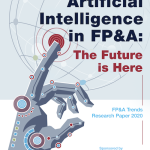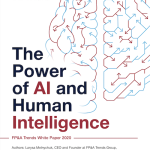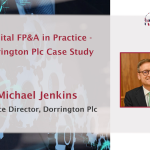The result is this paper that covers the elements crucial for any organisation approaching AI or ML for the first time including challenges, methods...
Introduction
FP&A Trends Group hosted another AI/ML Committee meeting on the 29th of March, 2023. The eighteenth session was scheduled on that day to celebrate the birthday of this think-tank. Five years ago, Larysa Melnychuk established the AI/ML Committee for senior finance practitioners and thought leaders to share the best practical experience of implementing and using the newest technology in their organisations. In addition, this committee focuses on helping FP&A leaders better understand the impact which AI/ML may have on the financial planning industry.
Many leading finance professionals have presented their insights since 2018, and this meeting followed the pattern. This time we invited Scott Campbell, Head of Center of Excellence - Finance & FP&A at Philips, a long-time AI/ML Committee member, to be a speaker. The eighteenth AI/ML Committee featured a robust case study from Philips on Digital Finance.
How AI Makes Finance Digital at Philips
After introducing the agenda, Larysa gave the floor to Scott. He introduced himself and pointed at his non-typical background - he has studied microbiology. This knowledge allows him to compare enzyme structures to data models they use at Philips. Then he briefly described Philips' range of products and operations and emphasised how Artificial Intelligence/Machine Learning help them create the digital P&L.
Per Scott, Philips uses ML as an input for their digital planning. However, a diverse product line could have made the planning processes complex. Thus, they wanted to create a trusted sales plan from their team outside of finance. The next goal was to build a cost-of-sales plan around this to fill out the P&L. That is why they decided to use the power of ML to predict costs based on their sales. According to Scott, any planning process with AI still relies on human factors, such as the people in the markets and businesses making those final decisions to own the numbers.
With that in mind, Philips wanted to create a comprehensive digital plan and implement Machine Learning where it made the most sense. Also, they attempted to use digital drivers to develop a digital plan. Finally, they identified several ways to prefill the cost of sales and could run digital tooling for all of them. More importantly, they could also use this information to backfill the planning systems and make corrections if those were needed.
Scott also noted that the further you get into the planning process, the more people might have been guessing the outcome. Indeed, they wanted to prove that ML algorithms can predict everything as accurately as other financial colleagues and relieve them of this burden.
Then the speaker commented on Philips' business market combination of digital drivers. Despite starting their journey only a year ago, they have managed to preload all of their markets, cost of sales for our service organisation through an AI/ML, and prefill of predictions successfully.
3 Different Models They Use at Philips
The next point in Scott's presentation covered three different models in place at Philips. One of them is used in our sales (S&OP), which is outside of finance. Scott said they are highly connected with that team because they use the information the S&OP department provides as a primary input for their sales information. This model also encompasses available data about product introduction schedules and market growth for enriching ML algorithms.
The second one covers service components. They have been experimenting with which drivers correlate most to the results at Philips. FTE count information could be another highly-effective driver for predictions and driving their accuracy improvement.
The last AI/ML model is being used to predict the entire P&L for Philips. Here, they look at additional drivers that may impact P&L, such as inflation rates per country, shipping container costs, and even macroeconomic factors.
After that, Scott outlined the five steps ML at Philips completes to provide the business with accurate information:
- collect and prepare data;
- choose model and accuracy metric;
- training model;
- evaluate model results;
- choose the best model and make predictions with the model.
Moreover, Scott pointed out that each prediction cycle was their previous financial forecast. They used those forecasts not only for training the model but also for predictions. Hence, it allowed them to capture the predictions' accuracy and made it available to the whole team. In addition, they could evaluate what needed to be improved.
An In-Depth Look at ML at Philips
The next few minutes described three distinct training runs for AI/ML information validation. Data restriction and outlier handling, data additions, and hyperparameter tuning were among the parameters that allowed the Machine Learning algorithm to pick the best results of the 17 models and reduce the error function. The technology could then help them consolidate that information into one final answer. In fact, they let the system pick the best solution and publish the results. Consequently, they could then have a fact-based discussion about which solutions were working and which were not, and then they could deep dive into that information based on local knowledge to fine-tune their models.
Do You Need to Start from Scratch?
During his presentation, Scott noted that buying a planning tool with built-in AI is unnecessary. They decided to implement ML in their current system (Azure Databricks). However, it is crucial to ensure your team has the right skill set to operate it. Scott recollects that they hired the resources to fit the technologies, and they looked for data scientists with financial backgrounds.
To summarise his presentation, Scott shared his perspective on putting the digital P&L into practice. From his point of view, you do not need to make AI/ML a revolutionary part of your process. However, remember to have internal sponsors in the organisation - somebody who wants to drive the change. It is also worth separating AI/ML and planning teams from his perspective. Again, finding data scientist plays an important role.
Questions and Answers Session
The audience listened to the presentation attentively, and a very productive Q&A session began after Scott had shown his presentation.
Angelica Ancira, Global Digital Planning Lead, FP&A at PepsiCo, asked how to integrate AI/ML with the planning, especially local planning themes and models. Scott replied that the planning process starts before the forecast at Philips, so much work in the markets and businesses should be done before they produce a forecast. If the local FP&A teams could access the results of the previous predictions, they would trust that the algorithm works as it should. Since Philips continues to rely on the local finance teams for educational purposes, Scott believes that minor adjustments to data they could make were a part of their success.
Matthijs Schot, CFO Europe Region at Svitzer, asked about the benefits such an approach could bring. Scott enumerated the benefits they have already seen at Philips to answer this question. They were as follows:
- take the bias out of the forecasting and make it a bit more fact-based;
- employee engagement and benefit was that we could preload this information (which would take days out of the planning cycle);
- better forecast accuracy.
Sébastien Privel, Senior Director Financial Services, Global COE Reporting and Forecasting at the Coca-Cola Company, asked how they at Philips drove the confidence from the local FP&A teams along with local operations, that the output of the algorithm was at least as good as the planning that they had been doing before. It was related to Change Management, according to Sébastien.
Our speaker said they tried to educate the finance community within the company on AI/ML in general without paying attention to the predictions.
Second was the introduction of the Power BI dashboard, proving that they could repeatedly outperform by applying their localised knowledge, whether it is their models or the company's performance.
Right after it, Sébastien asked another question regarding assessing data quality at Philips. Scott summarised that they had to do a lot of error handling and smoothing of the training data to make the algorithms more effective.
Then, Tom Byrne, MD at T&B Solutions, raised another question. He wondered if any issues were distinguishing the seasonal drivers of costs versus exceptional drivers, which changed the environment. Also, he was curious if there was any discussion about adding value to help Philips' FP&A Team understand how their costs were being driven and wherever one could use them to make management decisions.
The presenter replied that there was no seasonality at Philips.
They saw a high correlation between sales and Machine Learning, and Scott exemplified it with helium prices. He said that when they dealt with the historical and future helium prices as input, these smoothed out the variants in their service model. The speaker emphasised that those things come from having detailed discussions with their market counterparts.
Amanda Zhou, Director, Business Operations & Financial Planning at Marklyn Co. Inc., asked Scott if they have leveraged on any external consultant companies or built this capability in-house. Scott said they made it internally but connected with several external partners regarding technology.
Then Larysa introduced the schedule of future meetings and invited the community to them. This time, 17 senior finance professionals joined the AI/ML Committee.
Subscribe to
FP&A Trends Digest

We will regularly update you on the latest trends and developments in FP&A. Take the opportunity to have articles written by finance thought leaders delivered directly to your inbox; watch compelling webinars; connect with like-minded professionals; and become a part of our global community.





